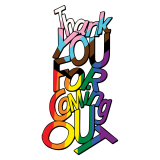BY BOB KRASNER | It’s said that those who do not know history are doomed to repeat it — but the Reclaim Pride Coalition, organizers of the Queer Liberation March, planned to do exactly that.
Fed up with what they call the corporate takeover of the Heritage of Pride March (the big one), they put together an alternative.
“It’s a march, not a parade,” explained photographer Dustin Pittman, who attended the first New York City gay-rights march in 1970. “This brings it back to its roots.”

With no floats or corporate sponsorship, Sunday’s alternative march took the same route as the first, from Sheridan Square to Central Park. Enthusiasm and handmade signs were the hallmark of pretty much every group involved, from the artists with the Howl! Happening gallery to the Revolting Lesbians.
Songs were sung (“Which Side Are You On?”) and chants were heard (“Off the sidewalk! Into the streets!”) all the way along the route, from what activist lawyer Norman Siegel estimated were 40,000 participants by the time they reached the park.

“There are 15 times more people here than I expected!” exclaimed activist Gene Fedorko, who was also there in 1970. “The energy is magnificent,” he enthused. “I’ve been crying all morning.”
Gay rights were just part of the agenda, as placards proclaimed the fight against all forms of injustice, including subjects such as abortion, ICE, sex workers, the N.R.A., white supremacy, Black Lives Matter, the rights of the incarcerated and even hairstyle appropriation.
“Stop stealing our haircuts,” read one lesbian’s sign.

The day culminated with a rally on the Great Lawn, a mix of comedy, political messaging and music. Organizer Leslie Cagan explained that the alternative march’s $200,000 budget was raised from foundation grants, fundraisers and personal donations.
“We were committed to making it a community event,” Cagan said.
Volunteers were also part of the equation, including the many who stayed behind to help clean up, as a result of a request from the stage.

Entertainment provided by BETTY, Justin Vivian Bond, John Cameron Mitchell and Kevin Aviance was balanced by the impassioned speeches of Cecilia Gentili and Larry Kramer, among others.
Kramer, the legendary playwright and AIDS activist, had a sobering message for the crowd.
“I’m approaching my end, but I still have a few years of fight in me,” he said.

These days, he noted, he is fighting against those who are spending their time looking for drugs and sex, rather than fighting to “make our world a better place.”
“I love being gay, I love my people,” he said. “Please give me something to be proud of again, in these dark and dangerous days.”
























































